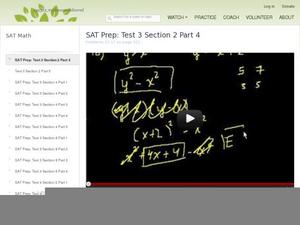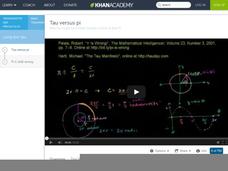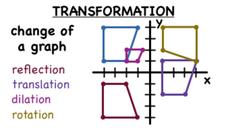Curated OER
What is the Formula for the Area of a Parallelogram?
So you are trying to tell me that a parallelogram is a rectangle in disguise? Wow! And I can use a similar formula of the area of a rectangle to find the area of a parallelogram? Wow! Ok, show me how! A=bh. So simple really.
Curated OER
Circles: Radius, Diameter and Circumference
Fascinating discussion regarding the origin of Pi accompanies a detailed explanation of how to find the circumference of a circle. Since this is the first installment in a series on circles, the concept of circumference is separated into...
Khan Academy
SAT Prep: Test 3 Section 2 Part 4
Finding perimeters and slopes is the focus of this video, which details ways to solve problems 15-17 on the practice SAT. Even students who are confident in their ability to pass the SAT would benefit from this additional review.
Khan Academy
SAT Prep: Test 1 Section 6 Part 5
Back with "more energy," Sal begins his explanation of problems 15-18 on page 412 of The Official SAT Study Guide. Problems include angles of equilateral triangles, rectangles, and graphing slopes.
Curated OER
Intro to the Trigonometric Ratios
This video introduces the basics of trigonometry. It starts by defining a right triangle and showing two different examples of finding the ratios of sine, cosine, and tangent using the SOH-CAH-TOA mnemonic. This resource could be used as...
Curated OER
Tau vs. PI
What�s wrong with Pi? In this video, Sal considers the question whether the number Tau (_), is a better number to use in our trigonometric model then the traditional PI (�). First, Sal reviews the definition of Pi, the trigonometric...
Teaching Channel
Algebra Skills: Support at Every Step
"My biggest challenge in class is to get some students to put a pen to paper, because they don't want to make a mistake." Discover how two teachers are working to help special education students develop the skills they will...
National Science Foundation
Science of NFL Football: Geometric Shapes
Ever wonder why a football has such an unsual shape? Find out with this video from the Science of Football colelction that examines how the geometric properties of a football make it perfectly suited for being thrown accurately over...
Curated OER
What are Skew Lines?
Skew lines? What? By definition, skew lines are lines on different planes that never intersect. Watch this video and get an explanation along with a visual diagram.
Curated OER
What is a Transformation?
A transformation is the process of changing the graph of a figure or a shape. The instructor introduces the four most common transformations: reflection, dilation, rotation, and translation. So watch as she draws the transformations on a...
Curated OER
What are Vertical Angles?
What makes vertical angles so special? Here's a few words that might help you figure out why: intersecting lines, congruent angles, opposite, supplementary angles. Still wondering? Then watch this video for a good explanation of vertical...
Curated OER
What is a Translation?
A translation means moving a figure to another location by sliding it. The figure, called the image, maintains its size and shape. You can move the image horizontally, vertically, or a combination of both.
Curated OER
How Do You Find Angle Measures for Adjacent Angles?
Two angles with given values are adjacent. Together they are 172.5 degrees. How do you find the degree of one of the angles? You will have to write an algebraic equation with the given information to solve for the value of the variable....
Curated OER
What Does Congruent Mean?
Two figures are congruent if they have the same size and shape. Line segments can also be congruent if they are of the same length. Vertical angles created by intersecting lines are always congruent. Polygons that have matching angles...
Curated OER
How Do You Make a Figure Larger Using a Dilation?
A dilation increases or decreases the size of a figure. In this lesson the teacher shows you how to use a scale factor of three to dilate the given figure. She identifies the ordered pairs, multiplies them by three, plots the new...
Curated OER
What is an Angle?
An angle is formed when two rays share a common endpoint. Want to know more about angles? There are a lot of terms in this lesson. You might have to watch it two or even three times to make sure you understand all the terms. I recommend...
Curated OER
What is a Tangent Line to a Circle?
This video defines what it means for a line to be tangent to a circle. It also defines the term point of tangency and shows how the radius drawn to the point of tangency is perpendicular to the tangent line.
Curated OER
How Do You Find the Volume of a Rectangular Pyramid?
How do you find the volume of a rectangular pyramid? Watch this video and find out! In the tutorial, a lecturer works through an example problem. While she works, she describes each step and each formula necessary to solve the problem. A...
Curated OER
What is a Sphere?
The teacher diagrams and explains the different terms of what comprises a sphere. Follow along and learn about the: radius, diameter, great circle, center, and hemisphere.
Curated OER
What's the Subtraction Property of Inequality?
Most of the rules that are used to solve equations can be used to solve inequalities. Take a look at the subtraction property of inequality. What is performed on one side of the inequality must be performed on the other side of the...
Curated OER
What are Complementary Angles?
Supplementary, obtuse, acute, complementary angles. It's good to know what all of these mean, but let's focus on one at a time. Complementary angles always add up to 90 degrees. So if given one angle in a complementary angle problem, the...
Curated OER
How Do You Find Angle Measures for Adjacent Angles?
Two angles with given values are adjacent. Together they are 172.5 degrees. How do you find the degree of one of the angles? You will have to write an algebraic equation with the given information to solve for the value of the variable....
Curated OER
What are Perpendicular Lines?
Perpendicular lines intersect to form right angles - four of them to be exact. Vertical angles, congruent angles, 90 degrees each, these are some of the special properties of perpendicular lines. Watch this video to find out a couple...
Curated OER
What is a Transformation?
A transformation is the process of changing the graph of a figure or a shape. The instructor introduces the four most common transformations: reflection, dilation, rotation, and translation. So watch as she draws the transformations on a...
Other popular searches
- Math Art Geometry Lessons
- Math Geometry Lessons
- Geometry/math Literature
- Esl Lessons Math Geometry
- Geometry Math Centers
- Geometry Math Stations
- Geometry Math
- 4th Grade Geometry Math Units
- Math Geometry Reflections
- Esol Lessons Math Geometry
- Traffic Signs Math Geometry
- Mummy Math Geometry























